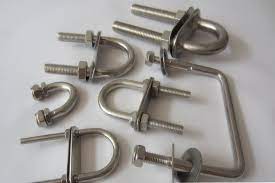Stainless Steel U Bolts: How Manufacturers Made It?

Stainless steel U bolts are one of the most fundamental engineering and construction components, and their production has evolved into a multi-step, high-tech process. Learn how raw steel is turned into exact metal instruments.
Bolts come in various sizes and shapes, but the primary manufacturing method is the same for all. After cold forging steel wire into the correct shape, it is heat treated and surface treated to increase strength and durability before being packaged for shipping. However, several additional procedures can extend the production process for more complex bolt designs.
What Are Stainless Steel U Bolts Used For?
Stainless steel U bolts are an industrial fastener used to secure pipe that transports liquids and gases. Their primary role is to apply a clamping force on two components in order to hold them together. The U-Bolt is threaded on both ends and, as you might expect, is fashioned like the letter “U.” When fastening pipe or other materials, the unusual U-bolt’s shape helps increase stability. U bolts, such as 304 stainless steel U bolts and 316 stainless steel U bolts, are widely used where corrosion resistance is required. There are two types of U-bolts: PTFE-coated U-bolts and neoprene-coated U-bolts.
Although the U-Bolt is most frequently associated with pipe security, it has proven to be highly flexible, with uses in a broad range of sectors, including automotive, construction, and architecture. They can be used as roof and foundation anchors and frames, cable, and pipe support. In the car industry, U-bolts are used to support engine gear components. U-bolt plates are also available in stock and are frequently used with U-bolts to provide additional support.
When Should You Use A U-Bolt?
U-bolts are a construction jack-of-all-trades. They have a wide range of applications, but they may be lifesavers when it comes to plumbing solutions. Here are a few instances of how they’re used in the pipe industry:
Restriction and Guidance
U-bolts may be used to limit the movement of tubes or pipes. That is, they prevent pipework from moving, colliding with other structures, and deteriorating.
On the other hand, Restraining pipes entails more than just pinning them down. In rare instances, holding a downpipe might lead to corrosion at the point where pressure is most concentrated. Instead of forcing vibrations into a focused spot, the U-bolt may be utilised as a guide to regulate movement. Pipes can move axially or through the pipe limitation but not up and down.
Shipping
U-bolts can also be used to keep pipes in place while being transported. The U-bolt may constrain pipes while creating a buffer between them and other metals, rather than allowing them to jump up and down and shatter.
Pipe Elevation
Finally, U-bolts are frequently used to suspend pipes. Gravity can be tough on plumbing, and the improper configuration can result in corrosion and things dropping. You can reduce vibrations and secure elevated lines by fastening a U-bolt to an above structure, beam, or ceiling.
How was the U-Bolt created?
U-bolts are available in a variety of materials. However, they’re frequently composed of corrosive-resistant metal. Some of the most common materials used in U-bolts are as follows:
- 304 stainless steel
- 316 stainless steel
- Plain carbon steel
Stainless steel U bolts manufacturers can apply protective coatings on top of these common essential parts. These coatings provide even higher corrosion resistance. The following are some of the most prevalent U-bolt coatings:
Plating with zinc
Zinc plating is the process of applying zinc to a surface by the application of an electrical charge. For interior uses, it’s usually a thinner layer.
Hot-Dip Galvanising
Hot-dip galvanisation adds zinc to the mix, but it’s a thicker finish. To build a connection, stainless steel u bolts manufacturers plunge the bolt in molten zinc, making the coating ideal for corrosive situations such as high humidity or salt in the air.
Coating with Fluoropolymer
A fluoropolymer coating is a corrosion-resistant combination of components. The coating is resistant to cracking in both hot and cold conditions.
Coating with Thermoplastic
The extra buffer between metals is the first advantage of adding a thermoplastic covering to U-bolts. Galvanic corrosion and structural failure can result from metal-on-metal contact. A thermoplastic coating produces a protective neutral layer between the piping and the restriction.
The cover has a low coefficient of friction, which allows the pipe to pass through the U-bolt while also protecting it. Broken pipes, restraints, and support structures are less likely to break due to this.
Conclusion
U bolts are a versatile item that may be used for various operations, including building and home repair. Folks must use the correct bolt for the job to avoid costly repairs and workarounds later. If a U bolt is used in a humid or corrosive environment, it should be made of rust and corrosion-resistant metal. When securing huge things, it’s also necessary to use a bolt that’s rated for big weights and to use a bolt that’s the correct width when straddling anything as a fastener.




